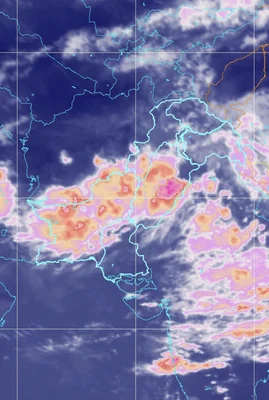
Climate Crisis: Heavy rain paralyzed Pakistan’s largest city Crédit d'image :
Publié le 29 juillet 2022, par Samir | 14 h 59 min
Temps de lecture : 4 minutes
The monsoon season has become more of a hassle than a blessing for Pakistan. As the world experiences climate change and its aftermaths, the intense rain spells hit the country, creating destruction in urban and rural areas. The densely populated city in Pakistan, Karachi, has to witness a hopeless situation as the public services and businesses close down. The torrential rains brought infrastructure loss, and people suffered badly as their daily activities halted badly. Climate Crisis: Heavy rain paralyzed Karachi PakistanHeavy rain paralyzed Karachi, Pakistan, the country’s central economic hub. The highest levels of rain affected Sindh and Baluchistan mainly, and according to official figures, more than three hundred people lost their lives from rain-related accidents, particularly in Baluchistan. Over nine thousand houses were severely affected or destroyed, whereas flooded roads, power outages, and electrocution incidents in urban areas of Sindh. The challenging rain spell created so many issues that the Sindh government announced a day off on Monday in two cities of Pakistan, Karachi and Hyderabad. Flooding situation near furniture market on Shahrah e Faisal in Karachi, the car completely submerged, heavy rains continue intermittently, so far the highest rainfall has been recorded 230 mm. Flooding wreaked havoc in Karachi, and dozens of cars submerged in water. According to statistics from the PMD, Baluchistan received more than 500%, Sindh 365% above regular rainfalls. Another hyperactive monsoon season will likely continue in August. Moderate to heavy rains could be seen in several areas of Karachi under the influence of monsoon circulation and moisture incursion from the Arabian Sea. For many days, the hashtag Karachi Rains kept trending on the microblogging platform Twitter, where tweeters shared the latest updates around flood-like situations in their areas. One of them posted: « Still mostly areas of Balochistan are under flood where people are asking for help have no drinking water food they immediately want rescue all around flood including Gandawa Jhal Magsi, Bela, Makran Coastal Highway, Bolan, Khuzdar. » Flash floods are likely to increase.Aisha Khan, the head of the Mountain and Glacier Protection Organization, said in a tweet, « Flash floods are likely to increase in frequency and intensity. Vulnerable mountain communities are at high risk. DRR must keep pace with a rapidly changing climate and simplify financial/ technical procedures to strengthen. » As per the latest reports, Pakistan Army extended its relief efforts in flood-hit areas of various Districts of Balochistan. In Uthal, 2300 individuals from four villages have been evacuated to safer places. Shelter and meals are provided to affected localities. The Highway which connects Quetta to Karachi has been operational for traffic blocked at four different places due to the collapse of bridges. In most Balochistan, telecommunication was restored in District Lasbela in coordination with PTA (Pakistan Telecommunication Authority). Climate change and poor infrastructurePakistan receives heavy rainfall from July to September, but the rains have not been normal this time. Experts believe that these rains have become more intense and dense. Afia Salam, a climate change advocate, said, « Climate change is a threat. We are a coastal city. It’s happening so fast, and we will bear the brunt. People must see the situation beyond individual events like a bridge falling or a road getting flooded. » Journalist Basil Andrews wrote in his tweet, « Recent rain spell has caused some serious flooding in Lasbela district and parts of Karachi. Seventy-two hours of intermittent rainfall over the Kirthar Hills has totaled 354mm of rain for July. Some 65% of it in the last three days. Catchment areas have flooded on both sides of the border. » He continued, « Small villages in Lasbela have been washed away in the deluge, the Hub Dam is overflowing while homes remain unsafe southwest of Thaddo Dam leading to Karachi. There are reports that the water continues to flow and inundate them. Average in July for Lasbela is 46mm, an extra 308mm for July. » The Climate crisis is a severe threat.Khan said, « Balochistan is a classic example of climate change with manifestations of extreme events-floods, drought, and heat. At the country level, we cannot stop global warming, but what we can do is be better prepared and equipped to respond to the exploding climate. » World Bank ReportAccording to Pakistan’s Climate Risk Country profile by the World Bank and Asian Development Bank (ADB), « Pakistan faces some of the highest disaster risk levels in the world, ranked 18 out of 191 countries by the 2020 Inform Risk Index. This risk ranking is driven particularly by the nation’s exposure to earthquakes and the risks of internal conflict. However, Pakistan also has high exposure to flooding (ranked 8th jointly), including riverine, flash, and coastal, as well as some exposure to tropical cyclones and their associated hazards (ranked jointly 40th) and drought (ranked jointly 43rd). Disaster risk in Pakistan is also driven by its social vulnerability. Pakistan’s vulnerability ranking (37th) is driven by its high multidimensional poverty rates. Pakistan scores slightly better in coping capacity (ranked 59th). » |
mar. 25 Joumada 2
الثلاثاء 25 جمادى الآخر |
| Contact | Mentions légales | A propos | Ressources | Blog | Glossaire | Questions réponses sur l'islam |
| Devenir musulman - Islam et terrorisme - Se convertir à l'islam - Prénom musulman - Roqya |
| English : al hamdulillah | Arabic : الحمد الله al-hamdoulillah.com © 2025 |